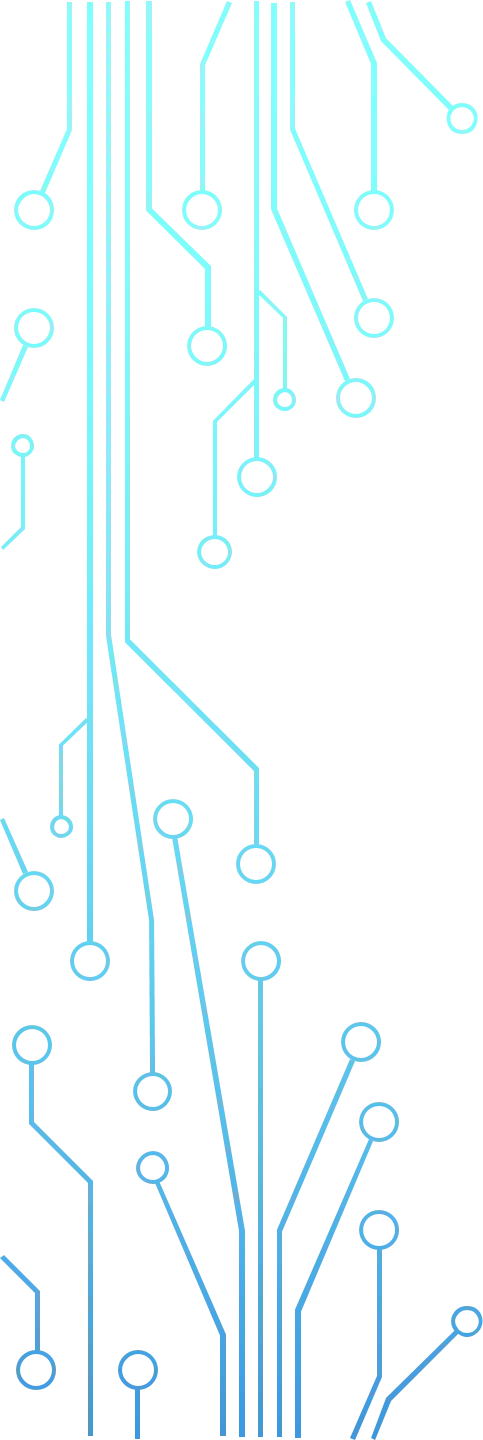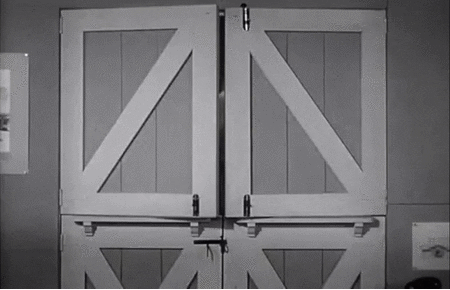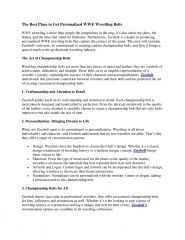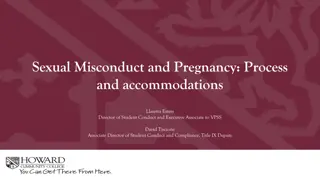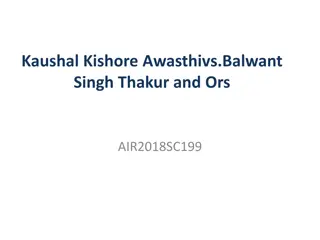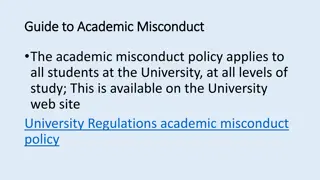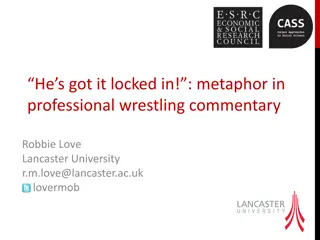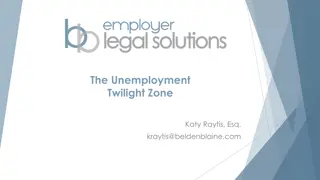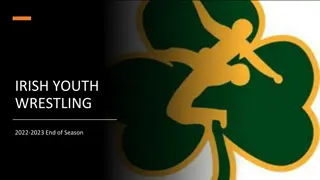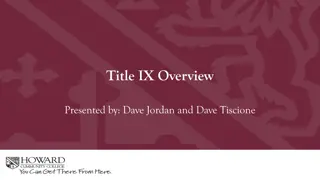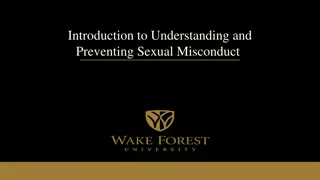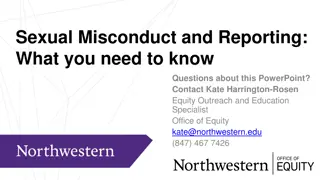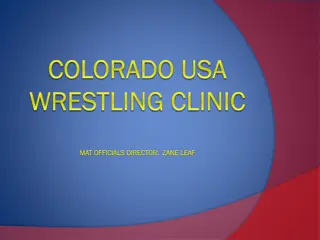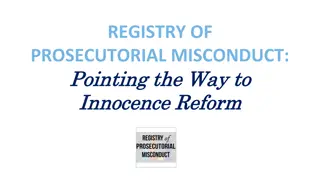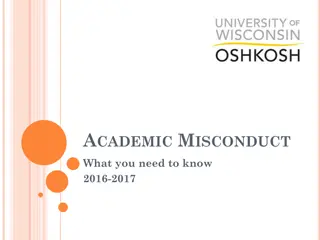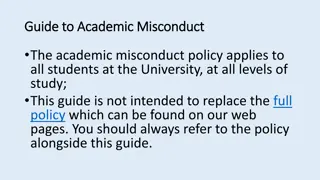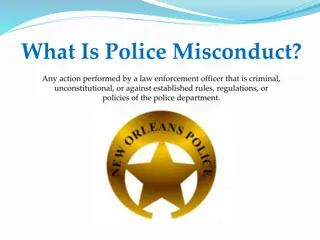Wrestling Rules and Misconduct Definitions
This content outlines rules and definitions related to wrestling, including definitions of bad time, penalties during bad time, coach misconduct penalties, and specifications for being inbounds while wrestling. It also covers the consequences for coach misconduct in wrestling matches.
Download Presentation

Please find below an Image/Link to download the presentation.
The content on the website is provided AS IS for your information and personal use only. It may not be sold, licensed, or shared on other websites without obtaining consent from the author.If you encounter any issues during the download, it is possible that the publisher has removed the file from their server.
You are allowed to download the files provided on this website for personal or commercial use, subject to the condition that they are used lawfully. All files are the property of their respective owners.
The content on the website is provided AS IS for your information and personal use only. It may not be sold, licensed, or shared on other websites without obtaining consent from the author.
E N D
Presentation Transcript
RULE 5 DEFINITIONS by Ed
Bad Time Bad time involves time that occurs when: a clock should have been stopped at the end of a period; or wrestling has been allowed to continue following a violation when the match should have been stopped Bad time is wrestled with the wrestlers in the wrong position or the wrong wrestler being given choice of position: a. at the start of the third period. b. at the start of the second 30-second tiebreaker. c. at the start of the ultimate tiebreaker. d. after opponent has taken his/her second injury time-out
ANY POINTS, PENALTIES, OR INJURY TIME THAT OCCURRED DURING BAD TIME SHALL BE VOIDED WITH THE FOLLOWING EXCEPTIONS flagrant misconduct unsportsmanlike conduct unnecessary roughness illegal holds/maneuvers; and blood time Head/Neck/Cervical Column (HNC) injury time
COACH MISCONDUCT When a coach requests a conference with the referee at the scorer s table regarding a possible misapplication of a rule, and it is determined there was no misapplication or when, during a conference at the scorer s table, the coach questions the judgment of the referee, coach misconduct shall be called. The coach misconduct penalty shall always be charged to the head coach. Coach misconduct results in the following: a. First offense warning; b. Second offense deduct one team point; c. Third offense deduct two team points and removal of the head coach for the remainder of the day. The penalty sequence starts anew each day. (See Penalty Chart)
INBOUNDS Contestants are considered to be inbounds if a total of two supporting points of either wrestler are inside or on the boundary lines. The total of two supporting points could be two supporting points of one wrestler or one supporting point of each wrestler that are inside or on the boundary lines Supporting points are the parts of the body touching the wrestling area which may or may not bear the wrestler's weight, other than those parts with which the wrestler is holding the opponent. When down on the mat, the usual points of support are: the knee(s) the side of the thigh the buttocks the hand(s) the head
INBOUNDS When the defensive wrestler is on their back while the supporting points of either wrestler are in-bounds wrestling shall continue. In this situation any part of a defensive wrestler's shoulder or scapula is considered to be all the supporting points. Near-fall points or fall shall be earned only while the supporting points of either wrestler are in-bounds. In a pinning situation, when all parts of the defensive wrestler's shoulders / scapula are on the mat beyond the boundary line, if the feet including toes and heels of the offensive wrestler are the supporting points, the offensive wrestler's knee(s) must be inside the boundary, whether in contact with or above the mat. A fall or near fall shall not be awarded if the wrestler being pinned is handicapped by having any portion of the wrestler's body off the mat.
TECHNICAL VIOLATIONS These are the types of technical violations. Each is penalized without warning asoutlined in Rule 7-3 a. Intentionally going out of the wrestling area or forcing an opponent out of the wrestling area to avoid an imminent scoring situation. b. Grasping of clothing, mat or ear guards. c. Interlocking or overlapping the hands, fingers or arms. d. Leaving the wrestling area without referee s permission. e. Reporting to the scorer s table not properly equipped, ready to wrestle or any equipment that is detected as being illegal after the match has started. f. Shoe coming off during wrestling action.
TIME-OUT ART. 1 . . . Injury time. If a contestant sustains an injury from a legal maneuver, the wrestler is entitled to a maximum of 1 minutes which is cumulative throughout the match, including overtime. Two injury time-outs may be permitted in any match provided the total time does not exceed 1 minutes. ART. 2 . . . Blood time. If a contestant bleeds, the wrestler will be charged with blood time which is a maximum of five minutes cumulative throughout the match, including overtime. ART. 3 . . . Recovery time. If a contestant is injured as a result of an illegal hold / maneuver, unnecessary roughness, unsportsmanlike conduct during the match or the result of a false start (by the opponent) in the neutral position, the wrestler is entitled to two minutes of recovery time, which is not deducted from the injured wrestler's injury time allowance nor shall it constitute an HNC time- out. (8-2-2)
TIME-OUT ART. 4 . . . Referee s time-out. If the referee needs to address a situation not covered by injury, blood or recovery time, a referee s time-out shall be charged. ART. 5 . . . Coach / Referee Conference. If a coach believes a misapplication of a rule has taken place a conference shall take place in front of the scorer s table. If a correction takes place it shall be a referee s time-out. Otherwise, the coach shall be charged with Coaches Misconduct in accord with the Penalty Chart. ART. 6 . . . Head / Neck / Cervical Column (HNC). If a contestant is injured, the onsite appropriate health-care professional (AHCP) will have up to five (5) minutes (maximum) to evaluate the wrestler s head and neck involving the cervical column and / or nervous system. A second occurrence of injury to the head and neck involving the cervical column and/or nervous system in the same match shall require the wrestler to default the match. (8-2-4a, 8-2-4b 1 & 2)
UNNECESSARY ROUGHNESS ART. 1 . . . Unnecessary roughness involves physical acts that occur during wrestling. It includes any act which exceeds normal aggressiveness. It would include, but it is not limited to: a) a forceful application of a cross face; b) a forceful trip; c) a forearm or elbow used in a punishing way, such as, on the spine or the back of the head or neck; d) pulling an opponent's hair. This does not include hair that is caught in a legal maneuver including but not limited to: a headlock, cradle, half-nelson, etc. ART. 2 . . . Continuing acts of unnecessary roughness may be construed as flagrant misconduct. Penalty points for unnecessary roughness shall be awarded in addition to points earned.
UNSPORTSMANLIKE CONDUCT ART. 1 . . . Coaches and Team Personnel. Unsportsmanlike conduct of coaches and other team personnel is any act which becomes abusive or interferes with the orderly progress of the match. These acts may occur prior to, during or after a match. This includes violations of the bench decorum rule (7-5-2), taunting, acts of disrespect, or those actions which incite negative reaction by others. The offender shall be penalized for unsportsmanlike conduct in accordance with the Penalty Chart. ART. 2 . . . Contestants. Unsportsmanlike conduct involves physical or nonphysical acts and they can occur before, during or after a match. It includes, but is not limited to, such acts as failure to comply with the direction of the referee, pushing, shoving, swearing, taunting, intimidation, baiting an opponent, throwing ear guards or any other equipment, spitting, the clearing of the nasal passage in other than the proper receptacle, repeatedly dropping to one knee to break locked hands, indicating displeasure with a call, failure to keep shoulder straps up while on the mat and failure to comply with the end-of-match procedure. Continuing acts of unsportsmanlike conduct or any unsportsmanlike conduct may be construed as flagrant misconduct. ART. 3 . . . Spectators. Any act (physical or non-physical), which in the opinion of the referee, is serious enough to warrant removal, shall cause the spectator to be removed from the premises for the remainder of the event. It is the home team administration or tournament director s / designee s responsibility to ensure a spectator is removed when directed by the referee.
SITUATIONS 5.1.1 SITUATION: In a dual meet, (a) Wrestler A was supposed to start the second 30-second tiebreaker in the top position, but the opponent was given the top position instead and it was brought to the attention of the referee 20 seconds into the second 30-second tiebreaker; or (b) Wrestler A was supposed to start the ultimate tiebreaker in the top position, but the opponent was given the top position instead and it was brought to the attention of the referee 20 seconds into the ultimate tiebreaker. RULING: In both (a) and (b), bad time would be applied as Wrestler A was not put in the proper position to start either the second 30-second tiebreaker or the ultimate tiebreaker. All points earned during bad time are canceled. Following corrections made and a rest of one minute, the second 30-second tiebreaker or the ultimate tiebreaker will be re-wrestled. (6-6-2)
SITUATIONS 5.7 SITUATION: During an injury time-out the coach informs the referee that the match is being defaulted because the injured wrestler is unable to continue. At that point the wrestler immediately stands up and goes to the center of the mat and says "I'm ready to continue." RULING: When the match is defaulted by either the coach or the wrestler, this terminates the match, and no additional wrestling can take place. (6-4-4)
SITUATIONS 5.10 SITUATION A: From the starting position on the mat, Wrestler B quickly stands up and: (a) strips the hands of Wrestler A and turns and faces; or (b) starts toward the edge of the mat, strips the hands of A and is more than an arm's length away with the back towards A as B goes off the mat; or (c) moves toward the edge of the mat and strips the hands of A just as B crosses the boundary line. RULING: In (a), B has escaped and will be awarded one point. In (b), it may be possible for B to gain an escape in this situation, provided A does not follow up and try to maintain the advantage. If, in the referee's opinion, B uses the boundary in order to stop wrestling after stripping the hands of A, there would be no change of control. In (c) no escape and wrestling will be resumed with the wrestlers in the same position following the out of bounds.
SITUATIONS 5.10 SITUATION C: Wrestler B stands up, gets hand control and begins to run away from Wrestler A. Both wrestlers go out of bounds. When the referee called the wrestlers out, Wrestler B was away from Wrestler A, but was not facing Wrestler A. Since no control was evident when both wrestlers went off the mat, should an escape be awarded? RULING: In order for an escape to be awarded, Wrestler B must be facing Wrestler A before the whistle or be a considerable distance away, such that Wrestler A has no chance to bring Wrestler B back under control.
SITUATIONS 5.11.2 SITUATION A: Wrestler A has Wrestler B in a pinning situation at the edge of the mat in the following situations: (a) B has only head and shoulders inbounds with the scapulars and the rest of the body out of bounds; (b) B has the left shoulder and scapula inbounds and the right shoulder and scapula out of bounds; (c) B has the scapulars inbounds with the shoulders and head out of bounds. In which of the following situations is it possible for Wrestler A to score a fall or near-fall points? RULING: The rule states that a fall or near-fall can only be scored if two supporting parts of either wrestler are inside or on the boundary lines. The 2 supporting points could be two supporting points of one wrestler or one supporting point of each wrestler that remain inbounds. Therefore, a fall or near-fall could be scored in all situations.
SITUATIONS 5.11.2 SITUATION D: Wrestler A, from a neutral position, takes Wrestler B directly to the back and has earned a three-point near-fall. B at this time becomes frustrated and locks arms around A's neck. The referee stops the match and awards A two points, then four points, then one point. A total of seven points. Is this correct? RULING: Yes. Two points for the takedown, a four-point near-fall and one point for the illegal hold / maneuver. 5.11.2 SITUATION G: Wrestler A turned Wrestler B with an arm bar and the referee is holding a 3-point near-fall. While B is still in the same pinning situation, Wrestler A changes moves and has B in a half nelson. Would the referee award a 3-point near-fall and start another count? RULING: The referee would continue to hold the 3-point near-fall even though Wrestler A changed moves, as Wrestler B never recovered from the pinning situation.
SITUATIONS 5.15.2 SITUATION D: In (a), Wrestler B has one shoulder out of bounds and one shoulder in bounds. In (b), Wrestler A is in a Peterson situation and Wrestler B has his / her shoulder / scapula on the boundary line. In (c), Wrestler A has a headlock while Wrestler B s shoulder / scapula is on the boundary line. RULING: In all cases, whether in bounds or out of bounds, Wrestler A can earn fall or near-fall because any part of Wrestler B s shoulder or scapula are considered to be all the supporting points.
SITUATIONS 5.18.2 SITUATION: From the neutral position, Wrestler A executes a takedown and establishes control on Wrestler B, who is out of bounds. Wrestler A s knees land (a) on the boundary line, or (b) beyond the boundary line. RULING: In (a), Wrestler A is considered in bounds because his / her knees land on the boundary line. In (b), the wrestlers are considered out of bounds because all of the wrestlers' supporting points are beyond the boundary line. COMMENT: Wrestler A would still be awarded the takedown if Wrestler A s feet finish down on the mat in bounds.

 undefined
undefined
